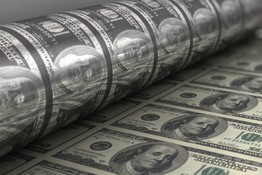 Printing Money: A large American industry
Printing Money: A large American industry
I’m sure you haven’t heard much about them, as Trump’s transition seems to take most of the corporate media’s time right now.
So let’s just go through these two changes ourselves to see what’s happening.
First, there are new liquidity rules for money market accounts.
The SEC changed this rule in October. It really means that a lot of open-end mutual funds will have to become closed-end.
This is a big deal and will create “sweeping change for the industry,” the SEC Chair said.
To put it in simple terms, many mutual funds and stocks and companies will no longer be able to have an unlimited number of shares.
They simply don’t have the liquidity – the cash – in case everyone wanted to redeem those shares all at once.
What we’re getting at is how shaky our economy is.
By doing this change, the SEC is making it clear that we need to make changes to fend off a market crash should a major sell-off occur.
I suspect we’ll see more people rushing to put their money into government securities.
Through rule manipulation, the government is pretty much forcing investors to lend to the government.
Remember, in 1997 when things went to hell it was the central bank that bailed out Wall Street.
In 2008 when things went to hell it was the taxpayers that bailed out the central banks.
When the next crash comes it’ll be depositors bailing out the central banks.
Or it could be the IMF.
We’ll see this bail out take place with negative interest rates, or the bank charging you money to keep your money in their bank.
We just have too much money floating around, thanks to years of quantitative easing by the Federal Reserve, or what we might as well just call printing up money.
In that regard, having more money on hand to back up the number of shares you’ve issued isn’t really a long-term fix – most of the money is just printed up and has no backing.
Well, it was some backing – how much confidence you have in it.
Let’s get to the second major change.
Over in India they probably have very little confidence in their money.
The country recently got rid of 23 billion bank notes, small bills that’d be the equivalent of the US getting rid of all its $10’s and $20’s.
Can you imagine that?
That move came on November 8 and in a single move, India wiped out 86% of its currency.
Cashless society, anyone?
I believe that’s the idea. It’s a lot easier to control your population when they don’t have cash.
People then have to rely on their financial institutions – many of which could be controlled by the government – to get small stipends of cash each day.
We saw this in Greece with lines at the ATMs and people getting about $60 a day when they might have had thousands of dollars in the bank.
We saw this on the day of the India announcement, when depositors were only allowed to pull out 2,000 rupees a day from the ATM.
That’s $29.
The changes won’t go fully into effect until January, but until then, people can trade in their now-worthless bank notes for digital currency.
Just some world economic changes I thought you should know about.
Thanks!

